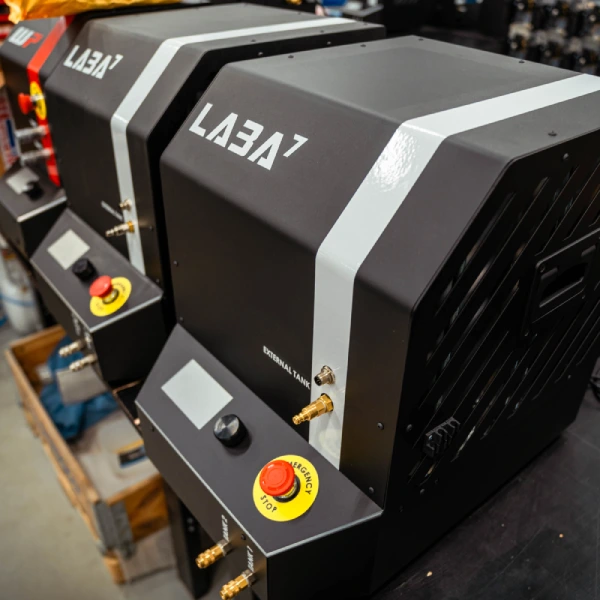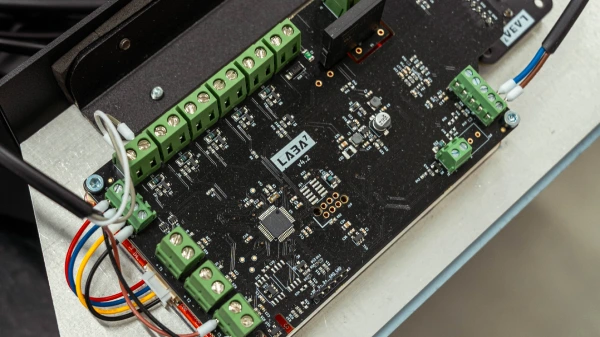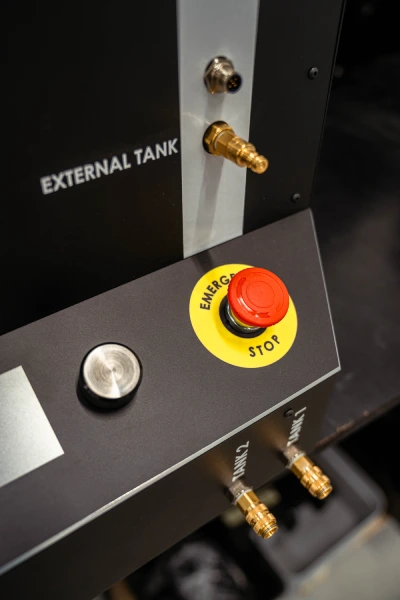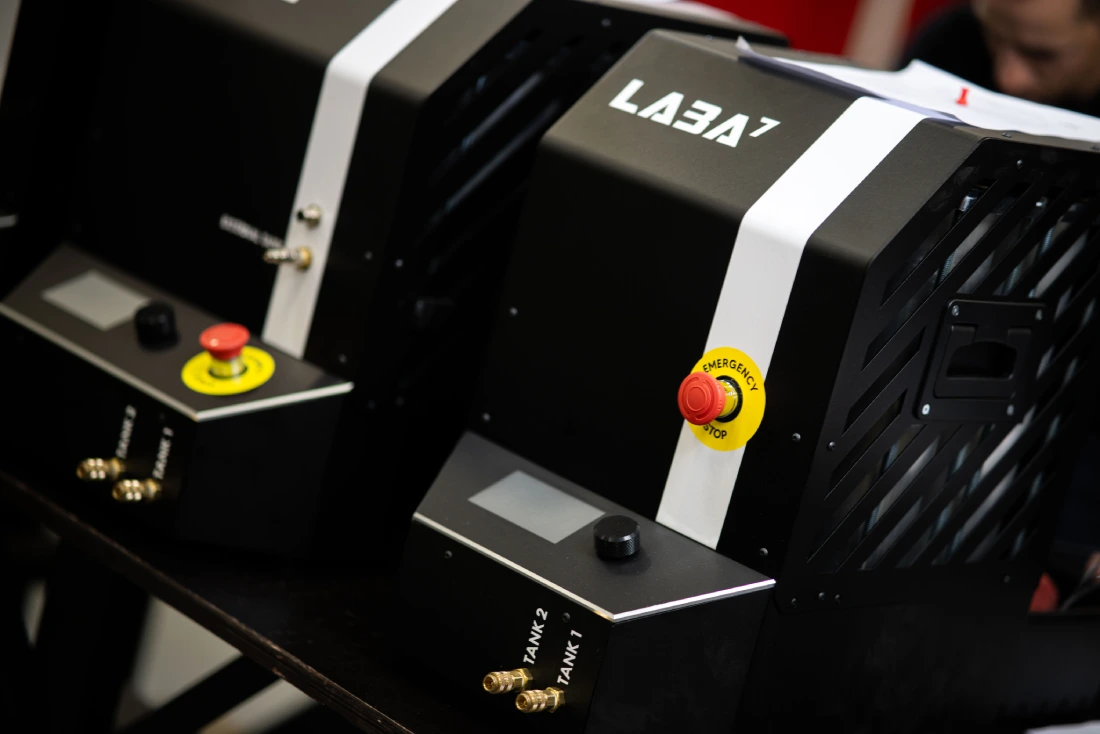Suspension vacuum pumps are essential to ensure optimal performance and safety in a vehicle’s suspension. Understanding how these machines work is crucial for any enthusiast or experienced mechanic. This comprehensive guide will cover everything you need to know about suspension vacuum pumps, from how they function to how to properly maintain them for long-lasting reliability and efficiency.
Table of contents:
- Overview of Suspension Vacuum Pumps
- Automatic Vacuum Bleed Pump
- Manual Shock Bleeding
- LABA7 Shock Pumps
- How to Bleed Shock Absorbers
- Vacuum shock bleeder adapters
- Frequently Asked Questions about Suspension Vacuum Pumps
Overview of Suspension Vacuum Pumps
Suspension vacuum machines, like the LABA7 shock pumps, can help remove any air bubbles or contaminants from your shock absorbers, resulting in smoother ride quality and better handling.
Function of Vacuum Bleed Machine
Shock absorbers and forks have a limit after which their damping qualities fade. Then it is time to service them and change the oil. That is where the shock vacuum pump comes in.
Vacuum bleed pumps are essential for ensuring that air bubbles are removed from the damper, allowing the shock absorbers to function properly. By creating a vacuum in the damper, these pumps eliminate any air pockets that can cause aeration or cavitation.
Types of Suspension Vacuum Bleed Machine
When it comes to suspension vacuum pumps, there are various types available on the market to suit different needs and preferences.
- One type is the automatic vacuum bleed pump, which offers a convenient and efficient way to bleed air from your suspension system.
- Another option is manual vacuum bleed pumps, which require the operator to track pressure, vacuum, and time.
- For those who prefer a hands-on approach, there are manual bleeding processes that require more time and effort and can be very messy.
Choosing the type of suspension vacuum pump will depend on your requirements and level of expertise in maintaining shocks.
Automatic Vacuum Bleed Pump

What is an Automatic Vacuum Bleed Pump?
An automatic vacuum bleed pump is the perfect tool for maintaining the optimal performance of your suspension. This advanced device removes air bubbles from your shock absorbers efficiently and ensures a consistent vacuum density.
An automatic vacuum bleed machine takes the guesswork out of the process, making it easy to keep your dampers in top condition.
Advantages of Using an Automatic Vacuum Bleed Pump
An automatic vacuum bleeding machine offers unparalleled advantages when it comes to maintaining and tuning your suspension.
The ease of use provided by these pumps allows for quick and efficient bleeding of multiple dampers with just a push of a button. Not only does it ensure the correct bleeding process and consistency in the process, but it also allows for customizable presets to tailor the bleeding process to your specific needs.
With a plug-and-play design, these automatic vacuum bleed pumps are a must-have tool for any serious suspension enthusiast looking to optimize their setup.

How to Use an Automatic Vacuum Bleed Pump
The process is very straightforward – connect a shock to the LABA7 vacuum bleed pump, select settings, and press the button. That is it. Automatic LABA7 shock vacuum machines will do the rest.
The process takes about 10-15 minutes, but the actual vacuum bleed machine speed depends on your settings. For example, you can choose several vacuuming cycles.
We made several videos of how to use LABA7 automatic vacuum bleed pumps.
- How to set up an automatic vacuum bleed pump
- How to bleed shock absorber with a bladder
- How to bleed shock absorber with a separating piston
- How to bleed two dampers at the same time
This list will expand over time. If you have questions, relating to shock absorber maintenance, contact us on social media.
Manual Shock Bleeding
Understanding Manual Shock Bleeding
This process involves manually removing air bubbles from the system and refilling it with fresh fluid to ensure optimal functionality. By utilizing a manual vacuum bleed, you can effectively purge any trapped air and prevent potential issues such as spongy brakes or inconsistent suspension response. It is important to follow proper procedures and use the correct tools to complete the manual vacuum bleed successfully.
Below we share a video on how to bleed shocks both manually and using an automatic vacuum pump.
Semi-automatic Shock Bleeding
The process is somewhat similar to automatic shock bleeding but requires the full attention of the operator. They also must understand and control pressure and vacuum levels, and the quantity of oil. What is being “automated” is the motor of the pump that sucks air and fills oil to a damper.
LABA7 Shock Pumps

Features of LABA7 Shock Vacuum Pumps
- Fully automatic damper bleeding process.
- Customizable presets allow you to service different types and sizes of dampers more easily and faster. All LABA7 pumps can save up to 8 different presets.
- High-density vacuum ensures that all air is removed from the shock or fork before filling it with fresh new oil. Our pumps can reach a vacuum level as low as 2000 microns. A lower vacuum can damage the internal parts of the damper, for example, shims.
- Altitude adjustment helps achieve desired results at any elevation.
- Our suspension vacuum bleed machines are powerful enough to service multiple shocks at the same time.
- PRO and MODULE pumps work with external vacuum pump tanks allowing to maintain different dampers without changing the oil in the pump.
- Dedicated adapters for AUTO, MOTO, and MTB dampers to service shock absorbers of any type.
Benefits of Using LABA7 Shock Pumps
- The damper vacuum bleed process is clean, quick, and effortless.
- LABA7 automatic bleed machines are designed to remove all air from the damper.
- Reduces gas content to a minimum to avoid aeration and cavitation.
- Can operate with all types of oil.
- Saves your time, money, and effort.
- Works seamlessly with other LABA7 tools for shocks.
Maintenance Tips for LABA7 Shock Pumps
After servicing 350 dampers, the pump will display a notification to check the oil level in the pump. Download the manual to learn how to do it.
That is about it.
How to Bleed Shock Absorbers

Importance of Bleeding Shock Absorbers
When it comes to maintaining the performance, reliability, and safety of your suspension system, one crucial step that should not be overlooked is bleeding shock absorbers. Properly bleeding your shock absorbers ensures that any air bubbles that may have built up in the system are removed, allowing for consistent and smooth operation. This process helps to optimize the overall performance of your suspension system, providing you with a comfortable and controlled driving experience. Additionally, bleeding shock absorbers can also extend the lifespan of your suspension components, ultimately promoting safety on the road. By prioritizing this maintenance task, you can ensure that your suspension system operates at its best, enhancing your overall driving experience.
Step-by-Step Guide to Bleeding Shock Absorbers
You can read this article on how to bleed shocks or watch this YouTube video.
Common Mistakes to Avoid When Bleeding Shock Absorbers
- Refilling with excess oil.
- Not removing all air bubbles while bleeding.
- Inserting air when assembling the compression adjuster on the final step.
Vacuum shock bleeder adapters
Regardless of the type of vehicle you’re using, there comes a time when the oil in the shocks and forks needs to be replaced. The LABA7 suspension vacuum pump provides an advanced method for removing air bubbles from fresh oil; however, using a dedicated bleed pump adapter specific to your type of damper can take the process to the next level.
Vacuum bleed pump adapters for AUTO
As a professional mechanic, it’s essential to stay versatile with car brands and their components that you can service. Considering this, we have developed dedicated vacuum bleed pump adapters for AUTO.
The automobile bleed machine adapter kit costs €350 and includes tips for 4 different types of dampers, including:
- 41.4×9.4 M6x1
- 41.4×9.4 M5x0.9
- 41.4×9.4 M4x0.75
- 60×7 M3x0.5
To enhance the service you offer to customers, consider investing in a state-of-the-art Glass adapter. This advanced vacuum bleed machine adapter enables you to easily identify if there are any air bubbles or other contaminants in the hydraulic fluid during the filling process.
Vacuum bleed pump adapters for MOTO
An intuitive vacuum pump for motorcycle dampers is essential to achieve the best results in maintaining your vehicle’s suspension system. However, a bleed pump without specialized vacuum bleed pump adapters for MOTO, is somewhat useless.
Therefore, we recommend you to buy the LABA7 MOTO adapter kit that supports 5 different brands of shocks for €350. The kit works with:
- WP – all shocks and WP steering dampers
- KAYABA – MX and Street
- SHOWA – MX and Street
- ÖHLINS – all shocks and steering dampers
- Mono Cross SACHS
There’s also an option to get vacuum pump adapters for motorcycle dampers with gas tanks attached to them. This LABA7 MOTO gas tank adapter kit costs €400 and supports 7 types of tips, with diameters ranging from 40 to 64 mm.
In case you need extra accuracy while filling the shock, you should take a look at the Glass vacuum bleed pump adapter. With it, you will be able to observe the quality of hydraulic fluid in real time, thus preventing contaminants in it.
Vacuum bleed pump adapters for MTB
It’s no secret that LABA7 is a team of all types of wheel enthusiasts; therefore, we have developed a dedicated suspension vacuum pump adapter for MTB. These adapters allow you to precisely remove air bubbles from different brands of mountain bike shock hydraulic fluid in no time.
To fulfill all your mechanical needs, we offer an entire MTB adapter kit for €350, which includes tips for these shocks:
- FOX FIT4, FIT CTD, RC2, DHX2, X2, DPX2, DHX Air, DHX RC
- Rockshox Brain (pre-2018 and post-2018), Charger, Pike, Lyrik, Yari, Boxxer, Monarch, Deluxe Plus, Vivid
- Öhlins TTX22M, RXF36
- Cane creek DB Inline
- Marzzochi Bomber RC (2018+)
For additional accuracy during the shock bleeding process, you can also get a Glass adapter built from top-notch materials and made for visual inspection of the hydraulic fluid.
Frequently Asked Questions about Suspension Vacuum Pumps
How strong of a vacuum pump do I need?
All LABA7 automatic vacuum bleed pumps can reach a vacuum as low as 2000 microns. A lower vacuum can damage the internal parts of the damper.
What is the most efficient type of vacuum pump?
An automatic vacuum bleed pump is the most efficient. The use of it is very streamlined, it works fast and saves your time.
You also might like these articles:

